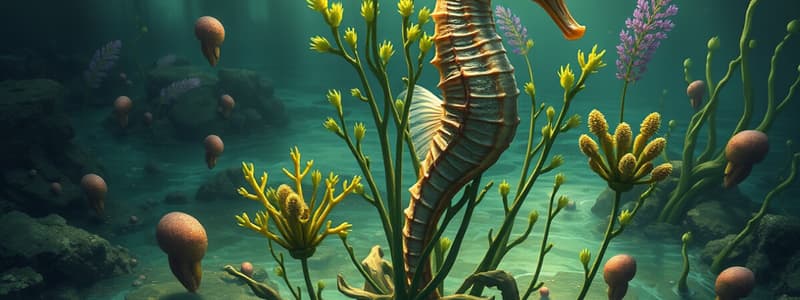Podcast
Questions and Answers
What is a characteristic of seahorses that helps them survive in the ocean?
What is a characteristic of seahorses that helps them survive in the ocean?
- They can fly to escape predators.
- They have legs for walking on the seabed.
- They have gills to breathe. (correct)
- They have a hard shell for protection.
What adaptation helps water lilies thrive in wetland environments?
What adaptation helps water lilies thrive in wetland environments?
- They can grow both above and below water simultaneously.
- They possess a waxy coating to repel water.
- They have long stems to reach for sunlight. (correct)
- They have long roots buried deep in the soil.
Where do most animals in the ocean tend to live for access to food and warmth?
Where do most animals in the ocean tend to live for access to food and warmth?
- Near the surface of the ocean. (correct)
- At the bottom of the ocean.
- In freshwater rivers.
- In deep trenches.
Which of the following animals is specifically adapted to stand in deep water?
Which of the following animals is specifically adapted to stand in deep water?
What type of environment describes a marsh?
What type of environment describes a marsh?
Flashcards are hidden until you start studying
Study Notes
Environment Overview
- Environment consists of living (plants, animals) and non-living (water, soil) components.
- Animals use sensory parts such as eyes, ears, and nose to locate food.
- Movement in animals is aided by body parts like legs, fins, and wings.
Ocean Environment
- Oceans are vast bodies of salty water, characterized by their depth and temperature variations.
- Most marine animals thrive near the surface where food and warmth are abundant.
- Plants in the ocean, like algae, predominantly live near the surface to access sunlight for photosynthesis.
- Algae serves as a primary food source for many sea creatures, including crabs and fish.
Example of Ocean Life: Seahorse
- Seahorses possess gills, enabling them to extract oxygen from water.
- Fins are essential for their movement and navigation in aquatic environments.
- They can change color as a defense mechanism to evade predators.
Marsh Environment
- Marshes are wetlands, regions where land is frequently covered with water, providing unique habitats.
- Wetlands play a critical role in supporting biodiversity and water filtration.
- Water lilies are a common plant found in marshes, featuring adaptations for their aquatic habitat.
Water Lily Adaptations
- Roots absorb nutrients from the waterlogged soil, vital for growth.
- Long stems elevate leaves, allowing for improved access to light and air.
Example of Marsh Life: Great Egret
- The great egret has a sharp, elongated beak adapted for catching fish and other food sources.
- Long legs allow the egret to stand in deep water, facilitating hunting in marshy environments.
Studying That Suits You
Use AI to generate personalized quizzes and flashcards to suit your learning preferences.




